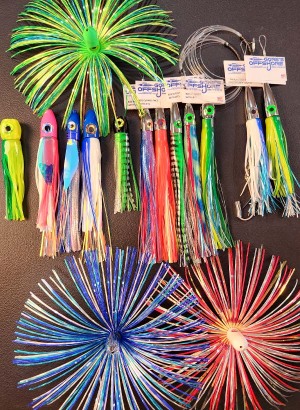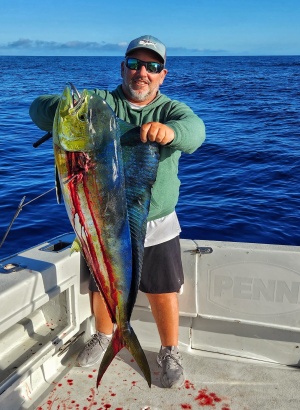Dolphin fishing is a popular sport due to their speed, agility, and brilliant coloration. They are prized for their challenge and deliciousness. Dolphins are found in tropical and subtropical oceans, primarily near reefs and open waters. They are also found in deeper waters. Dolphin fishing videos provide tools to level up skills and learn from world-renowned fishermen.

Dolphin Fishing - Know The Species
Dolphin fishing
Dolphin, also known as mahi-mahi, are highly popular among recreational sport fishermen. The combination of their speed, agility, and brilliant coloration, as well as their willingness to bite, make them a highly sought-after species for recreational anglers.
These beautiful fish are considered a highly prized gamefish, as they are not only challenging to catch but also delicious to eat. They are often caught while fishing for other species, as they are frequently found in the same areas as marlin, sailfish, and tuna.
In addition, dolphin are widely distributed and accessible to recreational anglers in different regions. Their popularity is further increased by the growth of recreational fishing tournaments, which often include dolphinfish as a target species.
Dolphinfish
The dolphinfish (Coryphaena hippurus), is known by several other names, including dolphin, dorado, dollies, mahi-mahi, and mahi. It is a highly sought-after sportfish due to its impressive size and agility. This fish species is highly valued by both recreational and commercial fisheries due to their large size and firm, white flesh, which is used in a variety of dishes.
Dollies are an iconic species of pelagic fish found in tropical and subtropical ocean waters. It is distinguished by its vibrant blue-green coloration, yellow-green back, and iridescent sides. Dolphin have an elongated body with a tapered tail and a large, pointed head. It can grow to be over a meter long and weigh up to 30 kilograms.
Dolphin are found throughout the tropical and subtropical oceans of the world, from the eastern Atlantic Ocean to the western Pacific Ocean. It is primarily found in nearshore waters, often near reefs, over sandy bottoms, and in open ocean waters. The dolphinfish is also found in deeper waters, up to 200 meters in depth.
Dolphin Fishing Videos
In The Spread dolphin fishing videos offer you the tools to level up your fishing skills. To learn more about specific tactics and techniques, tackle, line, leader material, rods, reels, rigs and to gain a wealth of knowledge from some of the world's finest fishermen, browse our library of Dolphin Fishing Videos.
Dolphinfish Taxonomy
Dolphinfish (Coryphaena hippurus) belongs to the family Coryphaenidae, which is a family of pelagic ray-finned fish commonly known as dolphinfish or dorados. Dolphinfish is a highly migratory species that is found in warm and temperate waters throughout the world, from the surface to a depth of around 330 feet.
The taxonomy of dolphinfish can be described as follows:
Kingdom: Animalia
Phylum: Chordata
Class: Actinopterygii
Order: Perciformes
Family: Coryphaenidae
Genus: Coryphaena
Species: C. hippurus
Dolphinfish are known for their speed, agility, and brilliant coloration, making them a popular target for recreational and commercial fishing. They are also important economically, as they are a valuable source of food in many countries.
Dolphinfish have a streamlined body, a large dorsal fin, and a distinctive, prominent snout. They are blue-green or silver-green on the back and sides and have a bright yellow to golden belly. They can grow up to 6 feet in length and can weigh up to 200 pounds.
In conclusion, dolphinfish (Coryphaena hippurus) is a highly migratory species of pelagic fish that belongs to the family Coryphaenidae and is found in warm and temperate waters throughout the world. Their taxonomy, distinctive physical characteristics, and ecological importance make them a unique and important component of marine ecosystems.
Predatory Characteristics of Dolphin
Dolphin are highly active predators, using speed and agility to pursue prey. They feeds primarily on small schooling fish, such as anchovies, sardines, and scad, as well as squid and invertebrates. It is an opportunistic feeder, using its sharp eyesight to locate prey, and then quickly pursuing them in a series of zig-zag bursts. It also uses its large mouth to suck prey into its mouth. It is an efficient hunter, capable of catching multiple fish in a single burst.

Behavior and ecology of the Coryphaena hippurus
Dolphin, or Coryphaena hippurus, is a highly active species of pelagic fish. It is known for its impressive size, vigorous swimming style, and bright coloration. It is an opportunistic feeder, preying on small schooling fish, squid, and invertebrates.
Dorado form large, temporary schools during the day, often over reefs or near the surface. They are fast and agile, capable of making sudden turns and bursts of speed to pursue prey. They are also known to jump out of the water, using the momentum of their jumps to capture prey.
Breeding Habits and Maturation Process of the Species
The dolphinfish breeds during the summer months, when water temperatures are between 24 and 28 degrees Celsius. Spawning occurs offshore, with the males and females forming large aggregations. The females release their eggs in batches, which are then fertilized by the males. The fertilized eggs float to the surface, where they hatch into larvae after a few days.
The larvae are planktonic, feeding on tiny organisms in the water column. As they mature, they become more active and begin to feed on small schooling fish. By the time they reach one year of age, they have usually become sexually mature.
They can grow up to a meter in length and weigh up to 30 kilograms by this time. They grow fairly quickly, with some individuals reaching a meter in length within their first year. On average, they grow between 3-5 centimeters per month. The adults are long-lived, with some individuals living up to ten years.
Migration Patterns for Dolphin
Dolphin are highly migratory, with some individuals traveling over 1,000 kilometers during their migrations. They migrate in response to seasonal changes in temperature and food availability. In the summer months, they move to cooler, offshore waters to spawn, while in the winter months they move to warmer, inshore waters to feed.
What is the Diet of a Dolphin
Dolphin are opportunistic feeders, preying on small schooling fish, squid, and invertebrates. Their diet can vary depending on where they are located, with some individuals feeding on different prey items depending on the season.
General Dolphin Fishing
Sport fishermen typically target dolphinfish by trolling with artificial lures or live bait. These techniques can be used both inshore and offshore, and are often used when the fish are schooling near the surface. Commercial fishermen typically use purse seines, set nets, and longlines to target dolphinfish. These techniques are more effective when the fish are in deeper waters.
While the fishing techniques used by recreational and commercial fishermen are generally similar, commercial fishermen often rely on more advanced techniques due to the larger sizes of dolphinfish they target.
Seth Horne, Creator at In The SpreadChumming can be an effective technique for dolphin fishing, particularly after a school has been located. The chum attracts the dolphin and keeps them in proximity to your boat, making them easier to target. Chumming can also be used to attract dolphin away from reefs and other structures, making them easier to catch.
Using Artificial Lures for Dolphin Fishing
When targeting dolphin (also known as mahi-mahi), trolling lures and skirted baits work quite well. Trolling lures mimic the swimming action of small baitfish, while skirted baits imitate squid and other baitfish.
The type and size of the lure do matter, as dolphinfish have a preference for flashy, bright colored lures. Lures that are too big or too small may not be as effective, so I would recommend using lures that are around 7-9 inches in length and have a bright, eye-catching color scheme.
For trolling lures, I would recommend using daisy chains, ballyhoo rigs, and deep-diving plugs. For skirted baits, I would recommend using large ballyhoo, mullet imitators, and squid skirts. These lures are popular among recreational fishermen and have a proven track record of attracting dolphinfish.
The benefits of using artificial lures for dolphinfish include:
- Consistency: Artificial lures provide a consistent and controlled presentation, allowing anglers to target dolphin with precision.
- Durability: Artificial lures are often made of durable materials that can withstand repeated strikes and last longer than natural bait.
- Versatility: Artificial lures come in a wide range of shapes, sizes, and colors, making it easy for anglers to match the hatch and target dolphinfish in different conditions.
- Cost-effectiveness: Artificial lures are often more cost-effective than natural bait, especially if fishing in areas where bait is scarce or expensive.
- Ease of use: Artificial lures are easy to use and require minimal preparation, making them a convenient option for recreational anglers.
Overall, using artificial lures for dolphin provide a reliable, cost-effective, and efficient way to target these fish, making them a popular choice among recreational anglers.
Live Baits for Dolphin Fishing
Live or dead baitfish such as ballyhoo, pilchards, or bonito strips are excellent options for dolphin fishing. Live baits can be rigged on a hook or bridled, allowing them to swim freely and imitate a fleeing prey. Dead baits can be rigged in a similar manner or chunked and used as a scent trail.
The type and size of bait do matter, as dolphinfish have a preference for certain types of baitfish, and their feeding habits can change depending on the conditions. I would recommend using baits that are around 6-8 inches in length and mimic the size and color of the local prey species.
In fishing tournaments, live ballyhoo and pilchards are widely used due to their effectiveness in attracting dolphinfish. Tournaments may also allow the use of dead baits such as bonito strips or rigged ballyhoo. The use of these baits can be determined by the tournament's rules and regulations, so it's important to check beforehand.
Benefits of Using Live Bait
The use of live or dead bait has several benefits for dolphinfish (mahi-mahi) fishing:
- Natural Appeal: Live baits, such as ballyhoo or pilchards, imitate the natural prey of dolphinfish, making them more attractive to the fish. Dead baits also have a scent trail that can attract dolphinfish from a distance.
- Increased Chances of Bite: Live baits can swim and move naturally, imitating a fleeing prey. This can trigger a predatory response from dolphinfish and increase the chances of a bite. Dead baits can also provide a scent trail that can attract dolphinfish to the bait and increase the chances of a bite.
- Versatility: Live baits can be rigged in different ways to imitate different types of prey. Dead baits can also be rigged or chunked to create a scent trail. This versatility allows anglers to tailor their bait presentation to the conditions and preferences of the dolphinfish.
- Ease of Use: Live and dead baits are relatively easy to use and are readily available at most fishing tackle stores.
The use of live or dead baits for dolphinfish fishing offers several benefits, including natural appeal, increased chances of a bite, versatility, and ease of use. Both types of baits can be effective in attracting and catching dolphinfish, and the choice of bait will often depend on the angler's preference and the conditions.
Fishing Rigs for Dolphin
When it comes to fishing rigs for dolphin fishing, there are several popular rigs that are commonly used by recreational fishermen:
- Ballyhoo Rig: The ballyhoo rig is a popular choice for trolling for dolphinfish. It consists of a hook rigged through the nose of a live or dead ballyhoo, which is then towed behind the boat to imitate a fleeing baitfish. The ballyhoo rig is a versatile rig that can be fished at different speeds and depths, making it a good option for a wide range of fishing conditions.
- Trolling Lure Rig: Trolling lures are another popular option for dolphinfish fishing. These artificial lures mimic the movement of fleeing baitfish and can be rigged with a hook and trolled behind the boat. There are many different types of trolling lures available, including feathers, plugs, and spoons, each with their own unique action and sound.
- Skirted Trolling Lure Rig: The skirted trolling lure rig is a variation of the trolling lure rig that adds a skirt made of silicone or rubber to the hook. The skirt creates additional vibration and flash, making it a highly effective rig for dolphinfish.
- Dead Bait Rig: The dead bait rig is a simple rig that consists of a hook rigged through the nose or back of a dead bait, such as a mullet or mackerel. The dead bait rig is fished by trolling behind the boat or by drifting, and is often used in conjunction with a chum slick to attract dolphinfish to the bait.
In conclusion, these are just a few of the many fishing rigs that are popular among recreational fishermen when fishing for dolphinfish. The choice of rig will often depend on the conditions, angler's preference, and the type of fishing being done.
Gain more fishing skills with our powerful learning system of instructional fishing videos.
Seth Horne In The Spread, Chief CreatorUser Reviews






















